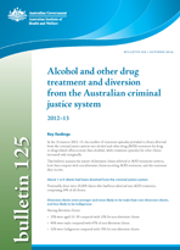Key findings1
In the 10 years to 2012-13, the number of treatment episodes provided to clients diverted from the criminal justice system into alcohol and other drug (AOD) treatment for drug or drug-related offences more than doubled, while treatment episodes for other clients increased only marginally.
This bulletin assesses the nature of diversion clients referred to AOD treatment services, how they compare with non-diversion clients receiving AOD treatment, and the treatment they receive.
About 1 in 4 clients had been diverted from the criminal justice system
Nationally, there were 24,069 clients who had been diverted into AOD treatment, comprising 24% of all clients.
Diversion clients were younger and more likely to be male than non-diversion clients, and less likely to be Indigenous
Among diversion clients:
- 25% were aged 10-19 compared with 11% for non-diversion clients
- 80% were male compared with 67% of non-diversion clients
- 12% were Indigenous compared with 15% for non-diversion clients.
Among diversion clients, about 1 in 7 also received non-diversion treatment during 2012-13
While there are client data for just 1 collection year, about 1 in 7 (3,640) diversion clients also received non-diversion episodes during 2012-13 (4% of total clients).
Diversion treatment episodes were about twice as likely to involve cannabis as the principal drug of concern compared with episodes for non-diversion clients
Diversion episodes were most likely to be for cannabis (43% compared with 20% for non-diversion episodes). This was followed by alcohol (21% compared with 46%), amphetamines (18% compared with 13%) and heroin (7% compared with 8%).
Police diversion episodes had less intensive treatment types compared with court diversion episodes
Police diversion episodes were far less likely than court diversion episodes to involve counselling (21% compared with 54%) and support and case management only (1% compared with 15%) as main treatment types, and much more likely to involve information and education only (46% compared with 20%) and assessment only (31% compared with 5%).



